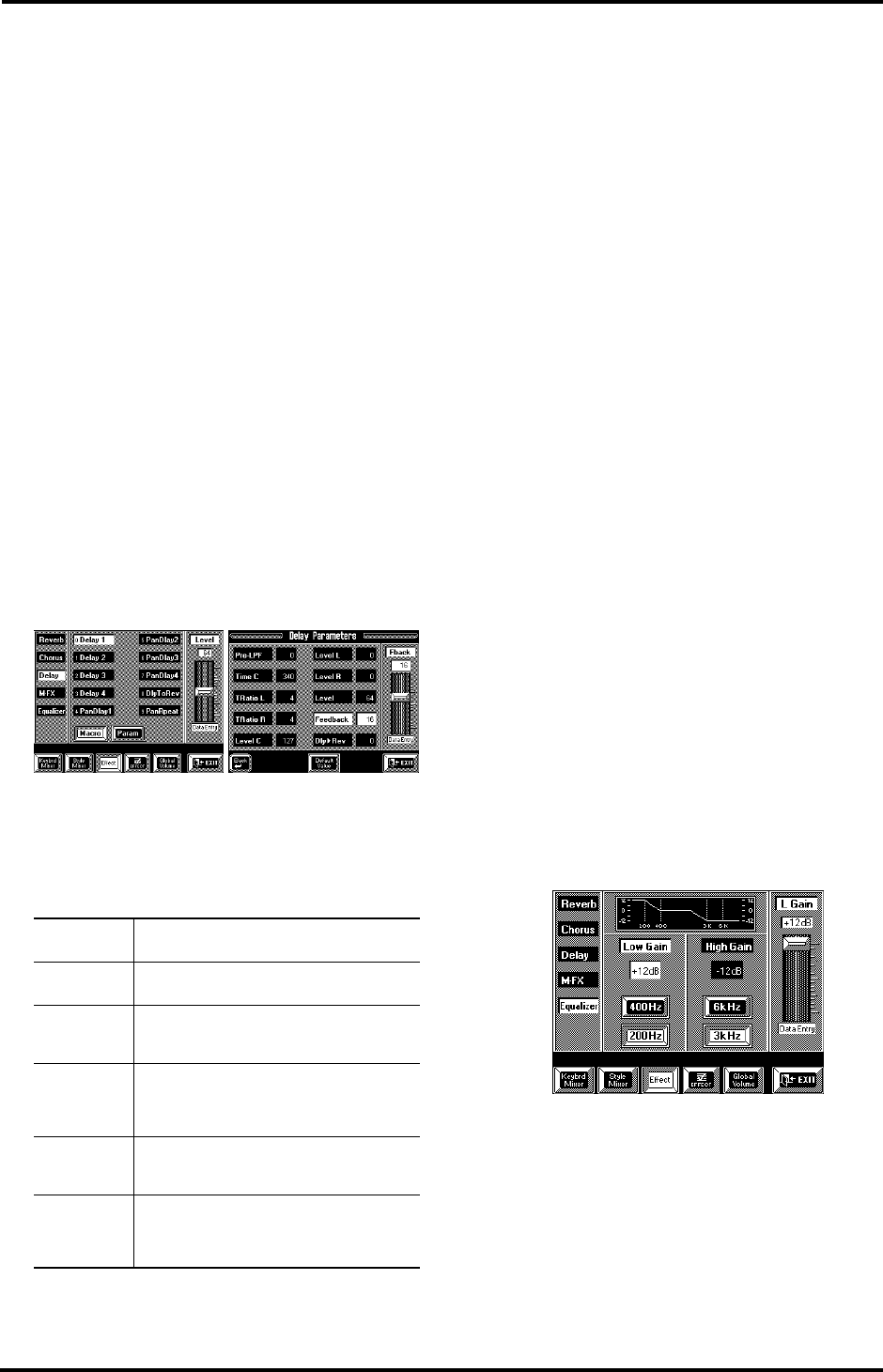
119
VA-76 – Effects and Equalizer
Rate (0~127)— This parameter sets the speed (fre-
quency) at which the Chorus sound is modulated.
Higher values result in faster modulation.
Depth (0~127)— This parameter sets the depth at
which the Chorus sound is modulated. Higher values
result in deeper modulation.
Cho® Reverb (0~127)— This parameter sets the
amount of Chorus sound that will be sent to the
Reverb. Higher values result in more sound being sent.
The value “127” effectively allows you to connect the
Chorus and Reverb effects in series (Chorus before
Reverb). If you do not wish the Chorus signal to be
processed by the Reverb effect, set this value to “0”.
Cho®Dly (0~127)— This parameter sets the amount
of Chorus sound that will be sent to the Delay. Higher
values result in more sound being sent. The value
“127” effectively allows you to connect the Chorus and
Delay effects in series (Chorus before Delay). If you do
not wish the Chorus signal to be processed by the
Delay effect, set this value to “0”.
Note: Press the [Default Value] field to recall the factory set-
ting for the currently active (white) parameter. Press the
[oBack] field if you want to select another Macro.
Delay types & Parameters
A Delay creates echoes. It is also possible to give depth
and width to a sound by adding a short Delay to the
original sound (a technique often used for rock-’n’-
roll songs and in Karaoke bars). You can choose from
among 10 types of Delay.
Pre-LPF (0~7)— A low-pass filter can be applied to
the sound coming into the Delay to cut the high fre-
quency range. Higher values will cut more of the high
frequencies, resulting in a more mellow Delay sound.
Time C (0.1ms~1.0s)— The Delay effect of the VA-76
allows you to set three Delay times: center (C), left (L),
and right (R). Time C sets the Delay time of the Delay
located at the center.
TRatioL/R (4%~500%)— This parameter sets the
delay time of the left- or right-channel Delay line as a
percentage of the central Delay. The value “100%”
means that the left or right Delay repeats at the same
speed as the center Delay.
Level C/L/R (0~127)— These parameters set the vol-
ume of the central, left, and right Delays. Higher val-
ues result in a louder Delay.
Level (0~127)— This parameter sets the overall vol-
ume of the three Delays (center, left and right). Higher
values result in a louder overall Delay.
Feedback (–64~ 0 ~+63)— This parameter specifies
the number of times the Delay will repeat. With a
value of “0”, the Delay will not repeat. With higher val-
ues there will be more repeats. With negative (–) val-
ues, the center Delay will be fed back with inverted
phase. Negative values are effective with short Delay
times.
Dly®Rev (0~127)— This parameter sets the amount
of Delay sound that is sent to the Reverb. Higher val-
ues mean that the Reverb portion will be more promi-
nent in the Delay signal. Be careful not to overdo this
effect because it tends to blur the sound image.
Note: Press the [Default Value] field to recall the factory set-
ting for the currently active (white) parameter. Press the
[oBack] field if you want to select another Macro.
Equalizer
This equalizer works the same way as the Treble and
Bass knobs on an amplifier. It allows you to boost or
cut the high and/or low frequencies of the Tones. By
boost we mean that the volume of a certain frequency
band is increased, while cut means that the volume is
decreased. The Low and High frequencies to be
boosted or cut are selectable.
1.
Select a Mixer page (see page 112), press the
[Effect] field, and the [Equalizer] field (left column).
Delay 1~3
These are conventional Delays. 1, 2 and 3 have
progressively longer Delay times.
Delay 4
This is a Delay with a rather short Delay time (a
kind of “slap back” effect).
Pan Dlay 1~3
The Delay sound moves between left and right.
This is effective when listening in stereo. 1, 2 and
3 have progressively longer Delay times.
Pan Dlay 4
This is a rather short Delay with the Delayed
sound moving between left and right. It is effec-
tive when listening in stereo (kind of stereo “slap
back” effect).
Dly To Rev
Reverb is added to the Delay sound which moves
between left and right. It is effective when lis-
tening in stereo.
PanRpeat
The Delay sound moves between left and right
channels, but the pan position is different from
the effects listed above. It is effective when lis-
tening in stereo.
VA-76.book Page 119 Friday, January 12, 2001 12:35 PM


















